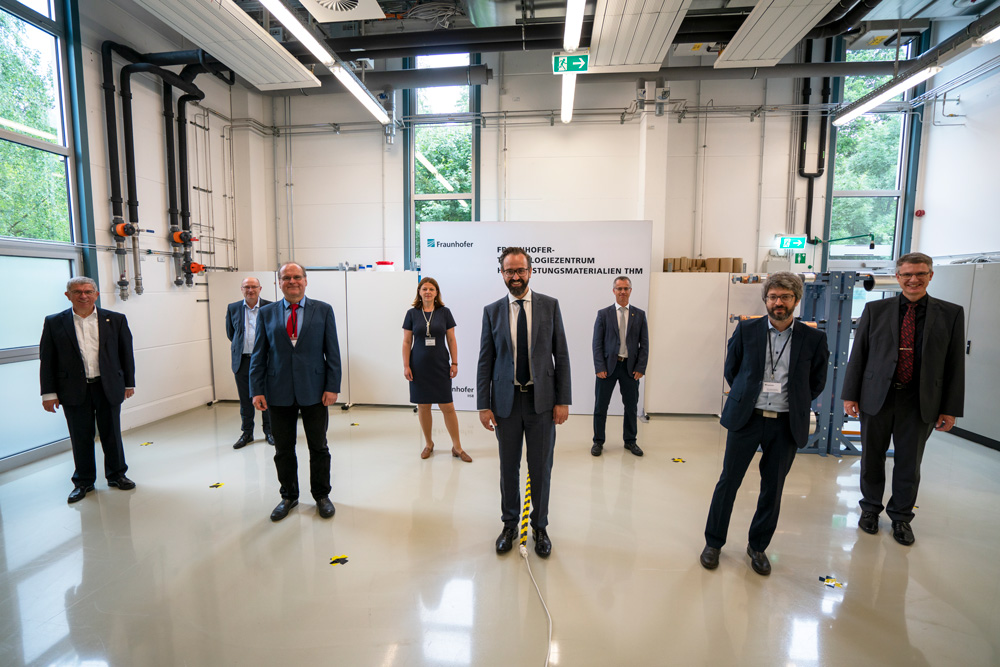Saxon Minister of Science Sebastian Gemkow is briefed on research projects at Fraunhofer Technology Center High Performance Materials THM in Freiberg
Research between battery recycling and quantum materials
Due to the energy transition, new technological and resource-strategic challenges arise for the German economy and for society as a whole. Many basic materials for electromobility, fuel cells, electrolyzers, power electronics and information technology will play a much more important role in the future. Often, these high-performance materials must be imported from other countries, which is a risk for material cycles in Europe. In addition, strategically important materials are lost to the economic cycles on a large scale every year because current recycling methods are not yet matured. Fraunhofer Technology Center High Performance Materials THM in Freiberg works on innovative solutions for all of these questions. Saxon Minister of Science Sebastian Gemkow gathered information on site about the progress.

“Here in the Free State, research institutions such as the THM are working on innovative solutions for the energy transition and circular economy”, emphasized Minister Sebastian Gemkow during his visit. “They make important contributions aimed at sustainability and value creation with their research and development as well as the transfer to application. This strengthens the science and high-tech location Saxony and helps to create additional jobs in the Free State.”
“For more and more companies in Saxony, modern recycling solutions are particularly important“, explains Dr. Mareike Partsch, who manages Fraunhofer THM together with Prof. Johannes Heitmann. This applies for the electric car plants in Zwickau, Leipzig, and Dresden as well as for the solar plants in Freiberg, the battery and ultra-capacitor manufacturers in Kamenz and Grossroehrsdorf or for many other companies. “We want to expand the collaboration between these players, coordinate big cluster projects and create industrial infrastructures for the circular economy of tomorrow.”, says Mareike Partsch, who is also an executive board member of “Energy Saxony”, a Saxon energy technology industry network. In this respect, Fraunhofer THM is also designed as a nucleus for new value-added chains and future-oriented industries in Saxony.
From downcycling to real battery recycling
An important research focus at Fraunhofer THM is battery recycling. There are already possibilities today to recycle lithium, cobalt, nickel, platinum, and other strategically important metals from waste batteries but as these elements are often present in very low concentrations, classical recycling processes are expensive and inefficient. Moreover, in practice they frequently lead to a “downcycling”, meaning a downgrading in the material cycles. The nickel extracted from waste batteries, for example, is not recycled in the battery production but is used as aggregate in the blast furnace. “We want to achieve a real recycling with our technologies instead of a downcycling”, emphasizes Mareike Partsch. “Meaning that we need to prepare the recycled materials in such a way that first-class batteries can be produced from them again.” For this purpose, the THM teams test different hydrometallurgical, mechanical, and electrochemical processes and combines them. They also want to ensure that engineers and designers think about the subsequent recycling already during the material and product development. The aim is to also apply these recycling technologies to solar modules, fuel cells, electrolyzers, and power electronics, because these systems also contain many valuable materials.
Small material defects for better power electronics
Power electronics are also of interest to the teams led by Johannes Heitmann – but from a different perspective: Due to their expertise in defect characterization, they can identify weak points in semi-conductor materials and thus make material developments more efficient. However, these material defects can also be useful: “Through purposefully installed defects in novel semi-conductor materials, electronic components can switch faster under certain circumstances or support higher voltages and stronger currents”, explains Physicist Heitmann. Such improved power electronics are the basis for the accelerated market penetration of electromobility or can enable solar plants with higher energy yield. “These intentionally installed defects can be used for quantum-physical phenomena for sensor and computing applications”, continues Heitmann.
These ambitious research projects were made possible not least by public funding. This includes five million euros that the Saxon State Ministry for Science, Culture and Tourism (SMWK) provides out of the European Regional Development Fund (ERDF) as start-up financing. The Federal Ministry of Education and Research (BMBF) granted another seven million euros as project funds for the activities of the partners in the framework program of the “Research factory battery”.